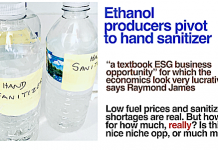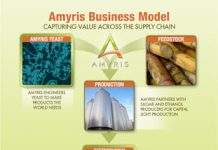Jim Lane
A quick overview of BioAmber (BIOA)
Company description
From the company’s 2013 S-1: “Our proprietary technology platform combines industrial biotechnology, an innovative purification process and chemical catalysis to convert renewable feedstocks into chemicals that are cost-competitive replacements for petroleum-derived chemicals. The development of our current organism was originally funded by the DOE in the late 1990s, was further developed and scaled up, and optimized at the large-scale manufacturing facility in France.
“We manufacture our bio-succinic acid in a facility using a commercial scale 350,000 liter fermenter in Pomacle, France…We have produced 487,000 pounds, or 221 metric tons, of bio-succinic acid at this facility…We believe we can produce bio-succinic acid that is cost-competitive with succinic acid produced from oil priced as low as $35 per barrel, based on management’s estimates of production costs at our planned facility in Sarnia, Ontario and an assumed corn price of $6.50 per bushel.
“We have secured funding to construct the initial phase of our next global-scale facility in Sarnia, Ontario and we intend to build and operate two additional facilities, one located in Thailand and the other located in either the United States or Brazil.
Rankings
30 Hottest Companies in Biobased Chemicals & Materials: #9, 2014-15
The Situation
Last May, we wrote: “What is exactly so special about a company making roughly 65 million pounds of a little-known renewable chemical, with a historically tiny global market? After all, that is roughly equivalent, by tonnage, to a 10 million gallon first-gen biofuels plant the kind that generally closes down these days because of a lack of economies of scale.
There are three reasons that we are looking carefully at BioAmber.
First, as former DOE Biomass Program Manager Paul Bryan opined at ABLC last year: “Focus on the right products first.” Bryan keyed in on biosuccinic in his ABLC presentation, highlighting the opportunities and advantages relating to the utilizing the oxygen in biomass.
Second, BioAmber is avowedly pursuing a strategy based in careful aggregation of strategic partners that bring investment and offtake as well as financing relationships, while building further applications for their molecules in work with R&D partners that could be expected to translate into commercial partners down the line. Which is to say, starting with an economically and environmentally advantaged molecule and then working in partnership with downstream customers to establish markets for that molecule.
Third, the process is cost-competitive with $35 oil.
Bottom line: It’s very different than the conventional biobased fuels strategy, which has been to set mandates to create market certainty, and use that to create a favorable financing environment, and encourage engagement with incumbents.
Top Milestones for 2012‐14
1. In December 2014, BioAmber announced it had signed an exclusive supply agreement for bio-based succinic acid with Oleon. Under the terms of the 5-year contract, which runs from 2014 to the end of 2018, BioAmber Sarnia, a joint venture with Mitsui & Co., will supply Oleon with bio-based succinic acid for the development and production of succinate lubricants.
2. In July, BioAmber priced a 2.8M share offering at $12.00 per share, and raised $33.6M. The company granted the underwriters in the offering a 30-day option to purchase up to an additional 420,000 shares of its common stock. Net proceeds, after underwriting discounts and commissions and other estimated fees and expenses payable by BioAmber were approximately $31.1 million.
3. In July 2014, the company announced a 210,000 ton per year take-or-pay contract for bio-based succinic acid with Vinmar International.Under the terms of the 15-year agreement, Vinmar has committed to purchase and BioAmber Sarnia has committed to sell 10,000 tons of succinic acid per year from the 30,000 ton per year capacity plant that is currently under construction in Sarnia, Canada.
It was just last week that the company announced a 210,000 ton per year take-or-pay contract for bio-based succinic acid with Vinmar International.Under the terms of the 15-year agreement, Vinmar has committed to purchase and BioAmber Sarnia has committed to sell 10,000 tons of succinic acid per year from the 30,000 ton per year capacity plant that is currently under construction in Sarnia, Canada.
4. In May 2014, BioAmber announced a contract to supply a minimum of 80% of PTTMCC Biochem’s total bio-succinic acid needs until the end of 2017. PTTMCC Biochem is a joint venture established by Mitsubishi Chemical and PTT, Thailand’s largest oil and gas company, to produce and sell polybutylene succinate (PBS), a biodegradable plastic made from succinic acid and 1,4 butanediol (BDO). The JV partners are building a PBS plant in Map Ta Phut, Rayong, Thailand that will have an annual production capacity of 20,000 tons, and is expected to be operational in the first half of 2015. The PBS plant in Thailand will consume approximately 14,000 tons of succinic acid per year at full capacity under the new agreement, BioAmber could supply a minimum of 11,200 tons of bioisuccinic acid if that PBS plant operates at full capacity. BioAmber plans to supply PTTMCC from its 30,000 ton per year plant under construction in Sarnia, Canada.
5. In May 2013, BioAmber announced the pricing of its initial public offering of 8 million units consisting of one share of common stock and one warrant to purchase half of one share of common stock at $10 per unit, before underwriting discounts and commissions.
6. In September 2012, Inolex launched a new range of 100% natural and sustainable emollients, using bio-based succinic acid from BioAmber. The market for personal care esters is valued at over $500 million. The new succinate emollients are highly-versatile because of their sensory properties and outstanding ability to disperse pigments. These fluids can be used in skin care, hair care, color and antiperspirant products to provide shine and a light fast-drying emolliency. These emollients are suitable as alternatives to silicone fluids for improving skin-feel, as well as enhancing shine and texture in hair care products. In natural formulations, they can be used to reduce the greasiness of natural oils.
7. In February 2012, NatureWorks and BioAmber, announced the creation of their AmberWorks joint venture to bring new performance bio-based polymer compositions to market. NatureWorks brings to the joint venture a global commercial presence, established customer relationships, developed applications across a breadth of industries and deep experience in commercializing new-to-the-world polymers. BioAmber owns PLA/PBS compounding intellectual property and applies award-winning biotechnology and chemical processing to produce renewable chemicals.
8. In February 2012, BioAmber raised $30 million in its Series C round of financing with $20 million invested in November by Naxos Capital, Sofinnova Partners, Mitsui & Co. Ltd. and the Cliffton Group, and a second tranche of $10 million on February 6th, 2012 closed with specialty chemicals company LANXESS. BioAmber and LANXESS are jointly developing phthalate-free plasticizers and expect to begin sampling succinic-based plasticizers in 2012.
Major Milestone Goals for 2015-17
1. Moving beyond succinic. The market for succinic acid itself is relatively small. The key to BioAmber (and other developers, like Myriant) is finding a market for biosuccinic as a “drop-in” replacement for other, incumbent petroleum-based chemicals, addressing what BioAmber termed “a more than
$30 billion market opportunity.” That claim is yet to be proved and the hard yards of commercialization lay ahead for the company to develop novel markets at scale.
“We intend to convert bio-succinic acid to bio-BDO and THF, which are large volume chemical intermediates that are used to produce polyesters, plastics, spandex and other products.
“We intend to use our bio-succinic acid in the production of PBS, which enables this polymer family to be partially renewable, and modified PBS, or mPBS, which provides these products with higher heat distortion temperature and improved strength.
2. New commercial plant. “We have begun early works on the site in Sarnia including hooking up to the water and sewer system under Vidal Street,” says the company’s Executive Vice-President Mike Hartmann. “The $80 million project is being constructed at the LANXESS Bio-Industrial Park in Sarnia.
The site is located in a large petrochemical hub with existing infrastructure that facilitates access to utilities and certain raw materials and finished product shipment, including steam, electricity, hydrogen, water treatment and carbon dioxide,” the Sustainable Chemistry Alliance newsletter reported. The plant was expected to open in 2014. The company also intends to build a second North American plant by 2017,
Business Model:
“For future facilities, the company writes, “we expect to enter into agreements with partners on terms similar to those in our agreement with Mitsui and we intend to partially finance these facilities with debt. We expect to use available cash and the proceeds of this offering to fund our initial facilities, as well as our commercial expansion and product development efforts. For additional future facilities, we currently expect to fund the construction of these facilities using internal cash flow and project financing.”
Competitive Edge:
1. Cost-competitive, renewable chemical alternatives that offer equal or better performance.
2.. Using less feedstock per ton of output than most other sugar-based processes for biochemicals other than succinic acid.
3. Significantly lower greenhouse gas emissions than the processes used to manufacture petroleum-based products by sequestering carbon dioxide in the process of producing bio-succinic acid.
More about the company
The latest corporate presentation is here.
Jim Lane is editor and publisher of Biofuels Digest where this article was originally published. Biofuels Digest is the most widely read Biofuels daily read by 14,000+ organizations. Subscribe here.








